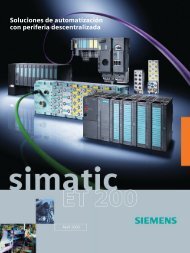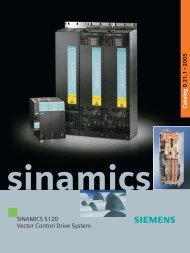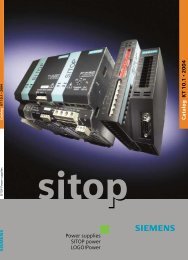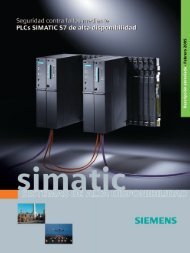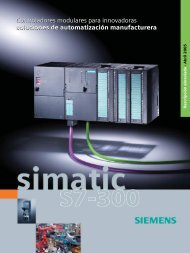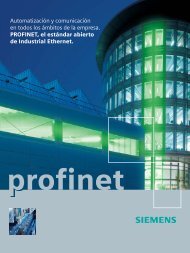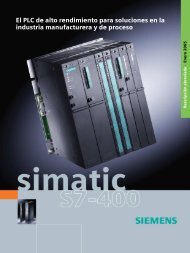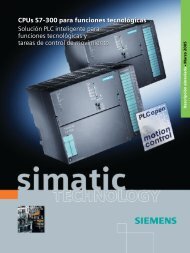SIMATIC PCS 7 process control system
SIMATIC PCS 7 process control system
SIMATIC PCS 7 process control system
Create successful ePaper yourself
Turn your PDF publications into a flip-book with our unique Google optimized e-Paper software.
<strong>SIMATIC</strong> <strong>PCS</strong> 7 <strong>process</strong> display: route network overview<br />
Route Control engineering<br />
The configuration of Route Control builds on the basic configuration<br />
of the <strong>SIMATIC</strong> <strong>PCS</strong> 7 <strong>process</strong> <strong>control</strong> <strong>system</strong> using<br />
blocks from the <strong>PCS</strong> 7 standard library. Even existing <strong>SIMATIC</strong><br />
<strong>PCS</strong> 7 plants are therefore easy to expand with <strong>SIMATIC</strong> Route<br />
Control.<br />
Technological elements of relevance to <strong>control</strong> of material<br />
transport (RC elements) are adapted in the CFC editor using<br />
uniform interface blocks from the Route Control library.<br />
The RC elements include:<br />
■ Control elements (actuators)<br />
■ Sensors elements (sensors)<br />
■ Parameter elements (setpoints)<br />
■ Connection elements (material information related to partial<br />
routes)<br />
Route Control library<br />
The Route Control library contains blocks for RC configuration,<br />
blocks for creating transport routes, and interface blocks for<br />
RC elements. It is made available in the catalog of the<br />
CFC editor.<br />
Route Control wizard<br />
The Route Control wizard constitutes the interface between<br />
the RC configuration and the <strong>SIMATIC</strong> <strong>PCS</strong> 7 basic configuration.<br />
The wizard, which can be called up from the <strong>SIMATIC</strong><br />
Manager menu, receives the RC-specific configuration data of<br />
the <strong>SIMATIC</strong> <strong>PCS</strong> 7 project for importing into the Route Control<br />
engineering. In doing so it carries out a plausibility check, defines<br />
the AS-RC server and AS-AS communication connections,<br />
and creates the RC server signals.<br />
Route Control Engineering tool<br />
Once the RC-relevant basic data of a <strong>PCS</strong> 7 project have been<br />
adopted in an RC project, the next step is to configure the<br />
RC-specific objects with the Route Control Engineering tool:<br />
■ Partial routes: through division of the transport paths into<br />
partial routes, it is possible to increase the flexibility and<br />
reduce the configuring overhead through repeated applications.<br />
Relevant partial route parameters: "bidirectional"<br />
and "priority" (lowest total of partial route priorities is decisive<br />
when searching for the overall route)<br />
■ Locations: marking of beginning and end of each partial<br />
route and thus also of the origin and destination of a material<br />
transport through plant points; these are parameters<br />
for the requirements of a material transport (origin, destination,<br />
intermediate points/via).<br />
■ Interconnections: "interconnection" of the RC elements<br />
through installation in a partial route; the elements acquire<br />
additional properties depending on their type<br />
(e.g. "close valve" in base position). These properties<br />
can be edited in configuration windows.<br />
■ Function catalogs: partial routes can be assigned to certain<br />
function catalogs, e.g. "Cleaning" or "Product transport",<br />
according to technological and product-specific aspects.<br />
When searching for routes, function catalogs allow<br />
you to limit the results to the type of material transport.<br />
■ Function steps/sequence functions: each function catalog<br />
includes as many as 32 configurable technological sequence<br />
functions, e.g. base position of the <strong>control</strong> elements,<br />
open transport valves, open origin valve, switch on<br />
pump. Together with the RC elements interconnected in<br />
the partial routes, the sequence functions determine the<br />
sequence of material transport.<br />
Special configuration functions make it easier to perform repetitive<br />
routine work and extend the range of options for <strong>control</strong>ling<br />
material transport, e.g.:<br />
■ Exporting configuration data in the form of CSV files to<br />
MS Excel, copying and editing the data there, and then importing<br />
the files back into Route Control<br />
■ Controlling the joint use of partial routes by configurable<br />
function IDs<br />
■ Checking material compatibilities and interlocking partial<br />
routes in case of incompatible material sequences based<br />
on the material ID saved in the connection element of the<br />
partial route<br />
■ Connecting dynamic (external) setpoints arriving from<br />
the <strong>process</strong> (e.g. weighed quantity) to the route block in<br />
runtime<br />
<strong>SIMATIC</strong> Route Control 39




